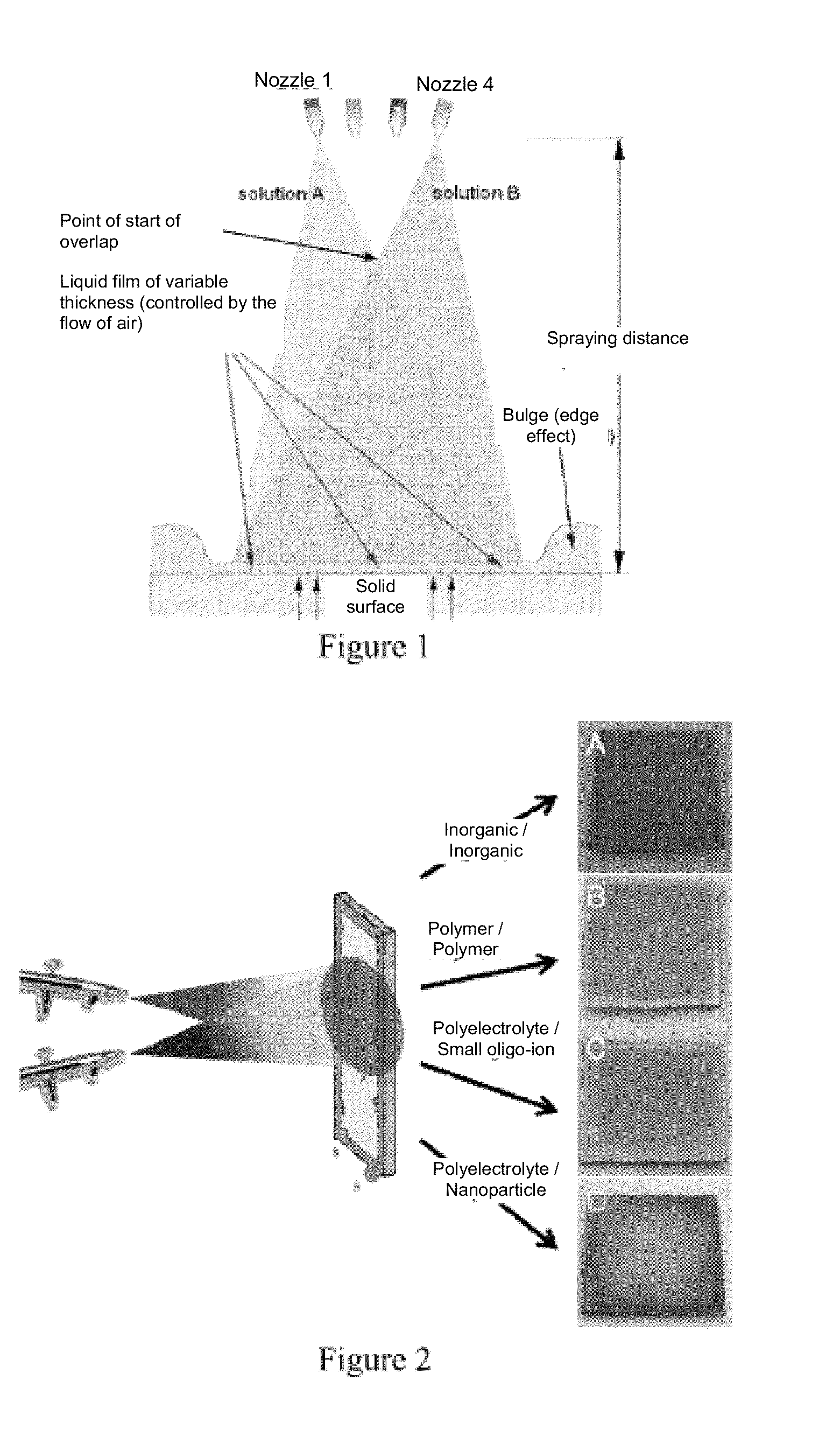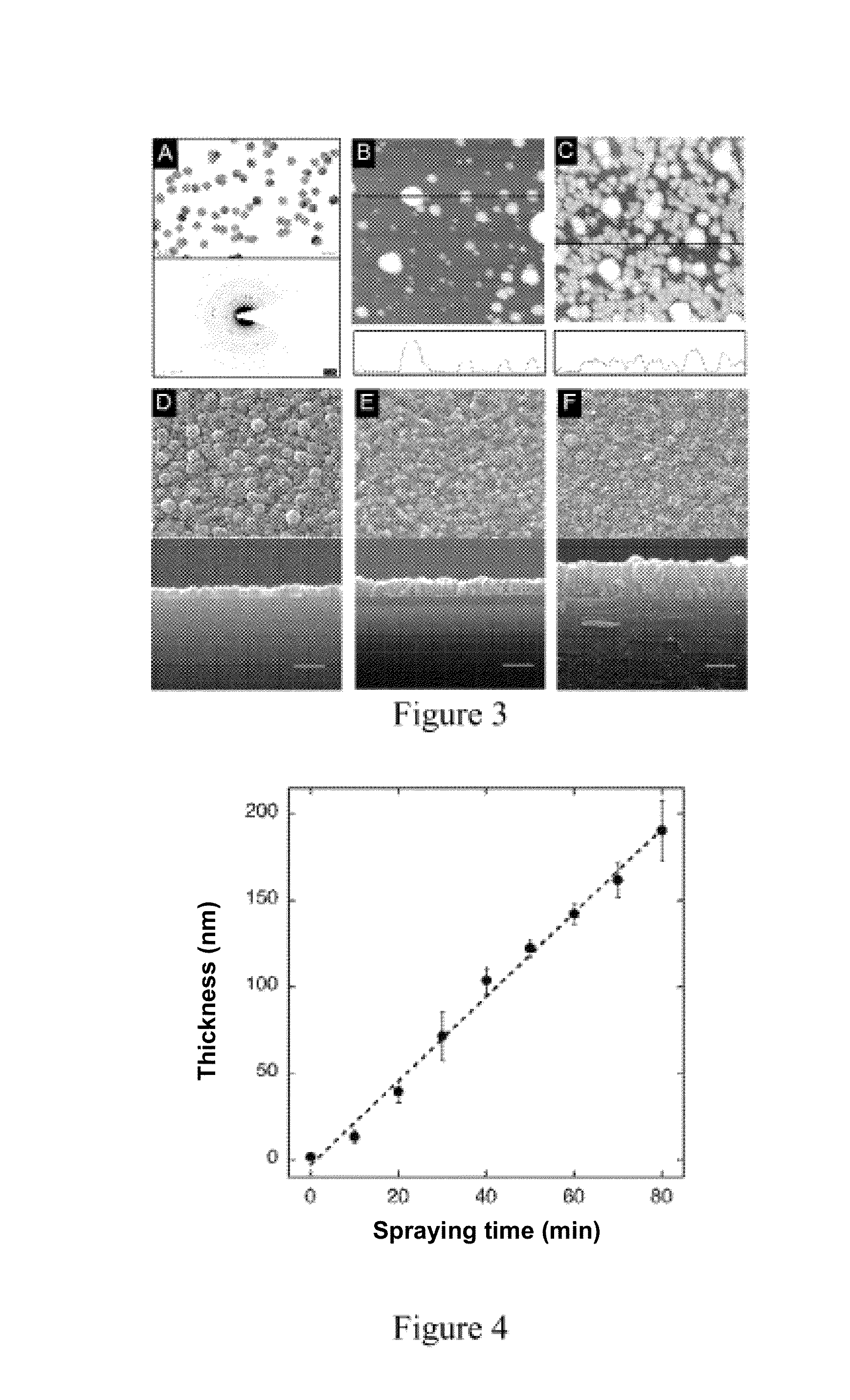Method for producing thin layers
a thin layer and layer technology, applied in the direction of liquid/solution decomposition chemical coating, packaging foodstuffs, packaged goods, etc., can solve the problems of high cost, high target utilisation sputtering, and limiting the use of small and simple objects, so as to achieve low polluting technology
- Summary
- Abstract
- Description
- Claims
- Application Information
AI Technical Summary
Benefits of technology
Problems solved by technology
Method used
Image
Examples
example 1
Formulation of the Technical Characteristics of the Simultaneous Spraying for Producing a Coating
[0205]Preparation of the Substrate[0206]The silicon wafers were cleaned by immersing them successively for one hour in a mixture of methanol and hydrochloric acid (50:50) and one hour in a concentrated sulphuric acid solution, then by thorough rinsing in ultra-pure water before use.[0207]The wafers of glass and quartz were cleaned with diluted solutions of Hellmanex® heated to boiling (100° C.) for 15 minutes, and thoroughly rinsed with ultra-pure water or in the same manner as the wafers of silicon.
[0208]Technical Characteristics of the Simultaneous Spraying:
For the coating obtained by simultaneous spraying, different airbrush models were used:[0209]model A480 of the firm Aztek, USA,[0210]model 280004 of the firm Sedip, France,[0211]model VL of the firm Paasche, USA.[0212]nozzle of the firm Spraying Systems Co, USA[0213]the pressurised gas was produced by different means:[0214]compresse...
example 2
Diversity of Applications of the Spraying Method According to the Invention
[0224]The technique of simultaneous spraying according to the invention may for example be applied to the spraying of inorganic / inorganic (case A), polymer / polymer (case B), polyelectrolytes / small oligo-ions (case C) and polyelectrolytes / nanoparticles (case D) solutions.
[0225]The covering of a silicon wafer by each of these couples was thus obtained by the present invention (see FIG. 2).
[0226]Example of application of case A: NaF (2.10−2 mol / L) and CaCl2 (1.10−2 mol / L).
[0227]Example of application of case B: polyethylene-oxide (0.5 mg / mL, Mw˜50,000 g / mol, with stabilisers) and polyacrylic acid (0.5 mg / mL, Mw˜100,000, 35% by weight in water) at pH 2.
[0228]Example of application of case C: PAH (1 mg / mL, Mn=56000 g / mol) and sodium citrate (0.02 mol / L).
[0229]Example of application of case D: PAH (1 mg / mL, Mn=15000 g / mol) and nanoparticles of gold (12 nmol / L)
[0230]The wafers (A, B, C, D) of FIG. 2 were obtained on...
example 3
Production of Inorganic Thin Layers by Simultaneous Spraying
[0231]For inorganic thin layers, it is important that the product obtained is less soluble in the reaction medium than the sprayed compounds (Table 1).
TABLE 1Solubility of inorganic compounds taken fromthe HandbookofChemistryandPhysics, 57th Edition,CRC Press, 1976-1977.Inorganic compoundsSolubility [g / 100 mL]Ionic solubility [M]CaCl274.5 [Ca2+] = 6.7(20° C.)NaF4.13 [F−] = 9.8(18° C.)[Ca2+] = 2.05 × 10−4CaF21.6 × 10−3[F−] = 4.10 × 10−4(18° C.)CaCl274.5 [Ca2+] = 6.7(20° C.)Na2C2O43.7 [C2O42−] = 2.76 × 10−1(20° C.)[Ca2+] = 5.23 × 10−5CaC2O46.7 × 10−4[C2O42−] = 5.23 × 10−5(18° C.)Ca(NO3)2, 4H2O121.2 [Ca2+] = 5.1(18° C.)(NH4)2HPO457.5 [HPO42−] = 4.36(10° C.)[Ca2+] = 1.83 × 10−3CaHPO4; 2H2O3.16 × 10−2 [HPO42−] = 1.83 × 10−3(38° C.)
[0232]For example, the method according to the invention lends itself well to the production of a thin layer of calcium fluoride according to the following equation:
CaCl2 (aq.)+2 NaF (aq.)->CaF2 (thin ...
PUM
| Property | Measurement | Unit |
|---|---|---|
| thickness | aaaaa | aaaaa |
| thickness | aaaaa | aaaaa |
| thickness | aaaaa | aaaaa |
Abstract
Description
Claims
Application Information
 Login to View More
Login to View More - R&D
- Intellectual Property
- Life Sciences
- Materials
- Tech Scout
- Unparalleled Data Quality
- Higher Quality Content
- 60% Fewer Hallucinations
Browse by: Latest US Patents, China's latest patents, Technical Efficacy Thesaurus, Application Domain, Technology Topic, Popular Technical Reports.
© 2025 PatSnap. All rights reserved.Legal|Privacy policy|Modern Slavery Act Transparency Statement|Sitemap|About US| Contact US: help@patsnap.com



